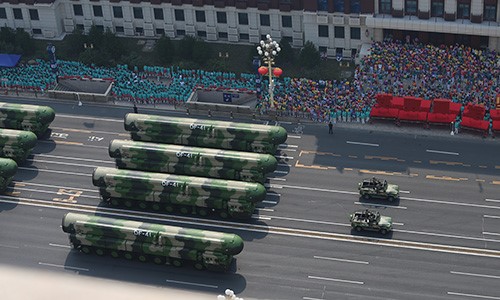For too long, China’s rapid increase in military power has been downplayed. That is a result of Beijing’s skillful use of economic influence over both key politicians and media outlets. The problem has become a crisis during the Biden Administration.
In 2021, key members of The House Armed Services Committee (HASC) reviewed testimony from Admiral Charles Richard, the Commander of U.S. Strategic Command, that China has moved a portion of its nuclear force to a Launch on Warning posture and has a nuclear weapons stockpile that is expected to at least double, if not triple, or quadruple, over the next decade. Based on most opensource estimates, to include those produced by the Department of Defense, this could bring size of the deployed Chinese nuclear deterrent to approximately 1,000 warheads by 2030. According to the China is fielding a full Cold War-style triad of nuclear assets — intercontinental ballistic missiles, nuclear-armed bombers and submarines capable of launching ballistic missiles. China’s ballistic missile arsenal is “more survivable, more diverse, and on higher alert than in the past, including nuclear missile systems designed to manage regional escalation and ensure an intercontinental second-strike capability.” Combined, these statements by Admiral Richard and Director Haines mean that China is likely to reach a degree of nuclear parity with the United States by the end of the decade.
Some outlets are beginning to comprehend the magnitude of the threat. In June, a Bloomberg report noted that “The US Needs More Nukes…Some Americans worry that building up the arsenal will start an arms race. Sorry, but China has already begun one.”
A Lowey analysis, citing information from the Bulletin of Atomic Scientists’ 2024 Nuclear Notebook warns that “Of the nine nuclear-armed powers, China is thought to have one of the fastest-growing nuclear arsenals at present. Last October, the US Department of Defence in its 2023 Annual Report made two forecasts: First, as of May 2023, China has more than 500 active nuclear weapons, exceeding earlier estimates. The 2022 report estimated that the stockpile had surpassed 400 nuclear warheads. Second, in keeping with its modernisation objectives, China is expected to have more than 1,000 operable nuclear weapons by 2030, many of which will probably be “’deployed at higher readiness levels.’ … if China continues with the pace of its nuclear expansion, at the rate anticipated in 2022, China is likely to have a stockpile of about 1,500 warheads by 2035, the timeline by which the Chinese military plans to “basically complete modernisation”. The New York Times also reported in December last year that China may be preparing a military installation to ‘test a new generation of nuclear weapons.'”
A Federation of American Scientist Nuclear Information Project examination reveals that its not just nuclear bombs bit also the means to launch those devices that have increased in number. The study states that “China has continued to develop its three new missile silo fields for solid-fuel intercontinental ballistic missiles (ICBMs), expand the construction of new silos for its liquid-fuel DF-5 ICBMs, and has been developing new variants of ICBMs and advanced strategic delivery systems. China has further expanded its dual-capable DF-26 intermediate-range ballistic missile (IRBM) force, which appears to have completely replaced the medium-range DF-21 in the nuclear role. China has been refitting its Type 094 ballistic missile submarines with the longer-range JL-3 submarine-launched ballistic missile (SLBM). China has recently reassigned an operational nuclear mission to its bombers and is developing an air-launched ballistic missile (ALBM) that might have nuclear capability.”
While Beijing is swiftly growing its atomic forces, the U.S. is heading in the opposite direction. In January, Senator Roger Wicker (R-Mississippi) warned “…critical updates to our arsenal are underfunded and behind schedule. Congress and the White House must act quickly to solve these problems and prevent more from emerging…. Satellite imagery reveals that China has built more than 300 new ICBM silos since at least 2021—more than the U.S. has constructed in the last five decades. Beijing has tested a new weapon capable of orbital nuclear attacks with almost no warning and set a pace to exceed the size of the U.S. nuclear arsenal by 2030. Russia already commands the world’s largest nuclear force. It is now fielding heavy ICBMs of almost unlimited range. The Kremlin also boasts a 10-to-1 advantage over the U.S. in shorter-range tactical nuclear weapons, as well as intercontinental-range nuclear-powered torpedoes and cruise missiles…the Biden administration’s economic policies and anemic military support have forced … all our urgently needed modernization efforts—to overcome staggering inflation and a lack of crucial technology suppliers, skilled labor and raw materials…”
Photo: China reveals its most advanced nuclear-armed intercontinental ballistic missile, the DF-41, at the National Day parade in Beijing on October 1, 2019. Photo: Fan Lingzhi/GT
